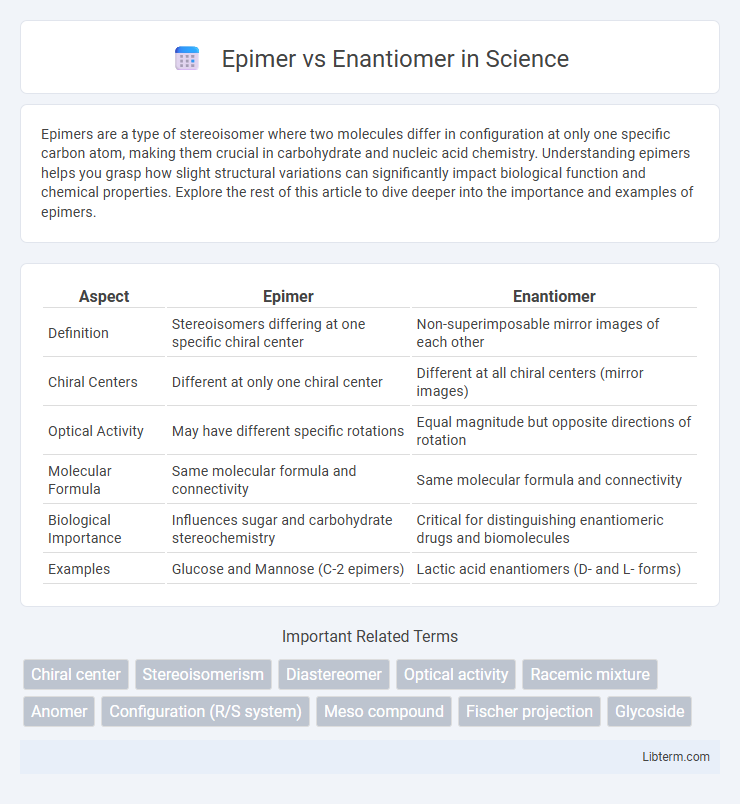Epimers are a type of stereoisomer where two molecules differ in configuration at only one specific carbon atom, making them crucial in carbohydrate and nucleic acid chemistry. Understanding epimers helps you grasp how slight structural variations can significantly impact biological function and chemical properties. Explore the rest of this article to dive deeper into the importance and examples of epimers.
Table of Comparison
| Aspect | Epimer | Enantiomer |
|---|---|---|
| Definition | Stereoisomers differing at one specific chiral center | Non-superimposable mirror images of each other |
| Chiral Centers | Different at only one chiral center | Different at all chiral centers (mirror images) |
| Optical Activity | May have different specific rotations | Equal magnitude but opposite directions of rotation |
| Molecular Formula | Same molecular formula and connectivity | Same molecular formula and connectivity |
| Biological Importance | Influences sugar and carbohydrate stereochemistry | Critical for distinguishing enantiomeric drugs and biomolecules |
| Examples | Glucose and Mannose (C-2 epimers) | Lactic acid enantiomers (D- and L- forms) |
Introduction to Stereoisomerism
Epimers and enantiomers are types of stereoisomers, compounds that share the same molecular formula but differ in the spatial arrangement of their atoms. Epimers differ at only one specific chiral center out of several present in the molecule, making them a subclass of diastereomers. Enantiomers are non-superimposable mirror images, differing at all chiral centers and exhibiting opposite optical activity.
Defining Epimers
Epimers are stereoisomers that differ in configuration at only one specific chiral carbon among multiple stereocenters, distinguishing them from enantiomers, which are non-superimposable mirror images differing at every chiral center. In carbohydrates, epimers like glucose and galactose vary at a single hydroxyl-bearing carbon, crucial for determining their biochemical properties. Understanding epimers is essential for studying sugar metabolism and enzyme specificity in biochemistry.
Defining Enantiomers
Enantiomers are a pair of stereoisomers that are non-superimposable mirror images of each other, possessing identical physical properties except for the direction in which they rotate plane-polarized light and their interactions with chiral environments. Epimers differ specifically in the configuration around a single stereogenic center, making them a subset of diastereomers rather than mirror images. Understanding enantiomers is crucial in fields such as pharmaceuticals because their distinct biological activities can lead to vastly different therapeutic effects.
Key Differences Between Epimers and Enantiomers
Epimers are stereoisomers that differ in configuration at only one specific chiral center, whereas enantiomers are non-superimposable mirror images differing at every chiral center. Epimers have distinct physical and chemical properties but share the same molecular formula and connectivity, while enantiomers exhibit identical physical properties except for the direction they rotate plane-polarized light and their interaction with chiral environments. The biological activity of epimers can vary significantly due to the single stereocenter difference, whereas enantiomers often have drastically different pharmacological effects despite closely related structures.
Structural Representation of Epimers and Enantiomers
Epimers differ in the configuration at a single stereogenic center out of several, resulting in distinct spatial arrangements of hydroxyl groups on sugar molecules, which is clearly depicted in their Fischer projections. Enantiomers are non-superimposable mirror images differing at every chiral center, represented by opposite stereochemistry in all stereocenters, often visualized through 3D models or dashed/wedged bond notation. The subtle differences in epimer structures affect specific functional group orientation, while enantiomers display complete stereochemical inversion, crucial for biochemical interactions and receptor binding specificity.
Biological Significance of Epimers
Epimers play a crucial biological role by influencing carbohydrate metabolism and enzyme specificity, as slight variations in stereochemistry at a single carbon profoundly affect molecular recognition and function. Unlike enantiomers, which are mirror images, epimers differ at only one stereogenic center, impacting the interaction with enzymes like epimerases that facilitate interconversion, essential in pathways such as glycolysis and the pentose phosphate pathway. These structural differences enable epimers to participate selectively in biochemical reactions, affecting processes like cell signaling and energy production.
Biological Significance of Enantiomers
Enantiomers are crucial in biological systems because they often exhibit significantly different pharmacological effects due to their interaction with chiral biomolecules like enzymes and receptors. Unlike epimers, which differ at only one stereocenter, enantiomers are non-superimposable mirror images that can influence drug efficacy, metabolism, and toxicity. This stereospecificity underlies the importance of enantiomeric purity in pharmaceutical development to optimize therapeutic outcomes and minimize adverse effects.
Methods to Differentiate Epimers and Enantiomers
Epimers and enantiomers differ in stereochemical configuration, requiring specific analytical methods for differentiation. Techniques like polarimetry measure optical rotation to distinguish enantiomers due to their non-superimposable mirror images, while NMR spectroscopy identifies epimers by detecting differences in chemical environments of stereocenters. Chromatographic methods such as chiral HPLC separate enantiomers based on interactions with chiral stationary phases, whereas epimers often require specialized derivatization or comparison of physical properties for differentiation.
Real-World Examples in Carbohydrate Chemistry
Epimers and enantiomers are stereoisomers with distinct differences: epimers differ at a single chiral center while enantiomers are non-superimposable mirror images. In carbohydrate chemistry, glucose and galactose are classic epimers, differing only at the C-4 position, whereas D-glucose and L-glucose serve as enantiomers, possessing opposite stereochemistry at every chiral center. These distinctions are critical for biochemical processes, influencing enzyme specificity and metabolic pathways such as glycolysis and galactose metabolism.
Summary and Conclusion
Epimers are stereoisomers that differ in configuration at only one specific carbon atom, typically seen in sugar molecules, while enantiomers are non-superimposable mirror images differing at all chiral centers. The distinction between epimers and enantiomers is crucial in stereochemistry because epimers have distinct physical properties and biological roles, whereas enantiomers exhibit identical physical properties but differ in optical activity. Understanding these differences enables precise manipulation in pharmaceuticals and biochemistry, impacting drug design and metabolic processes.
Epimer Infographic

 libterm.com
libterm.com